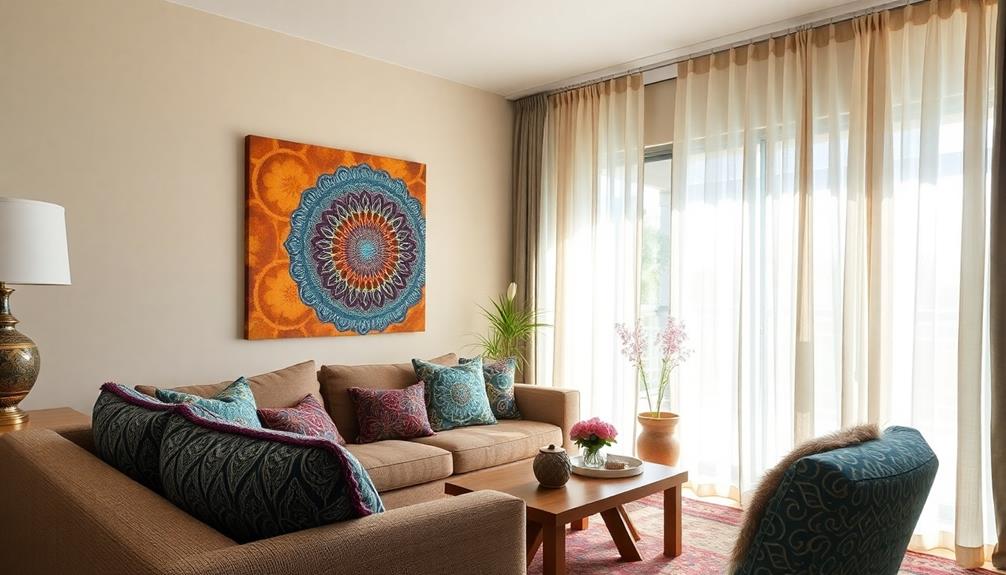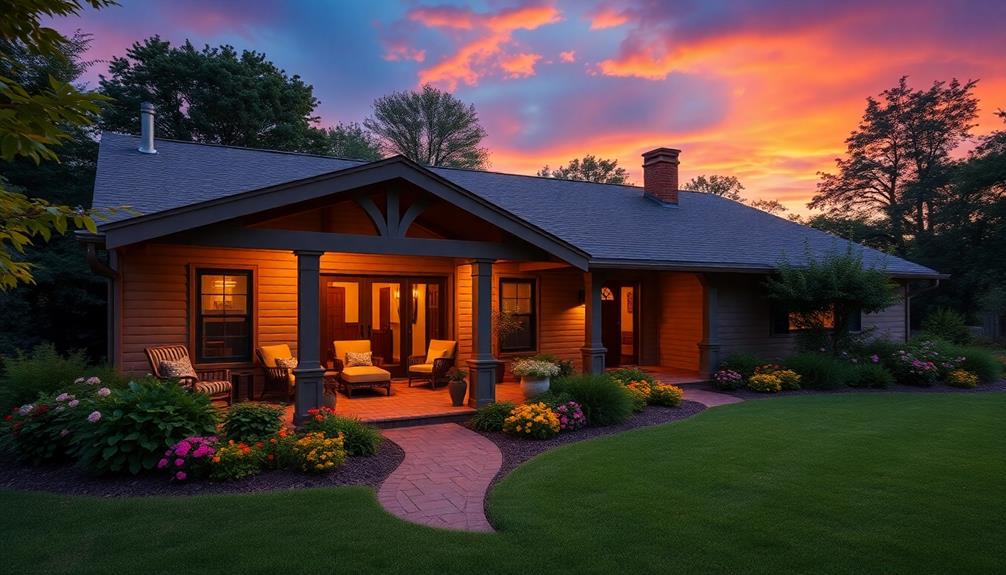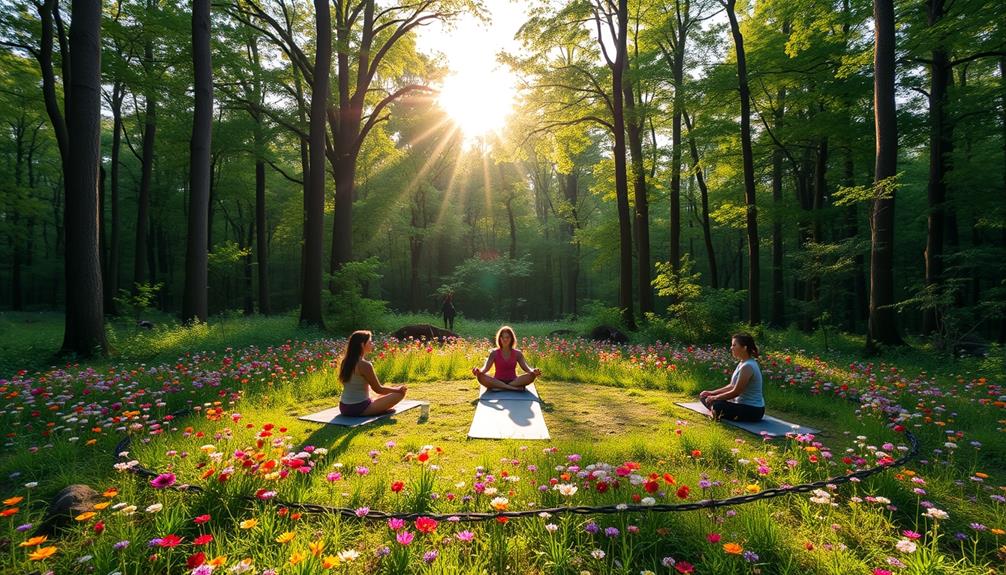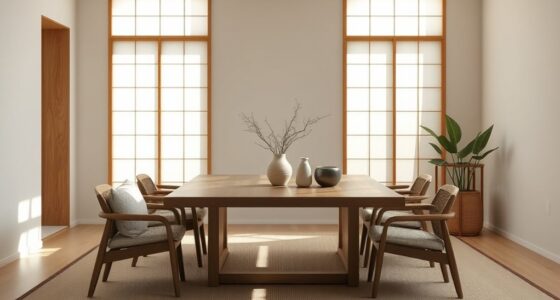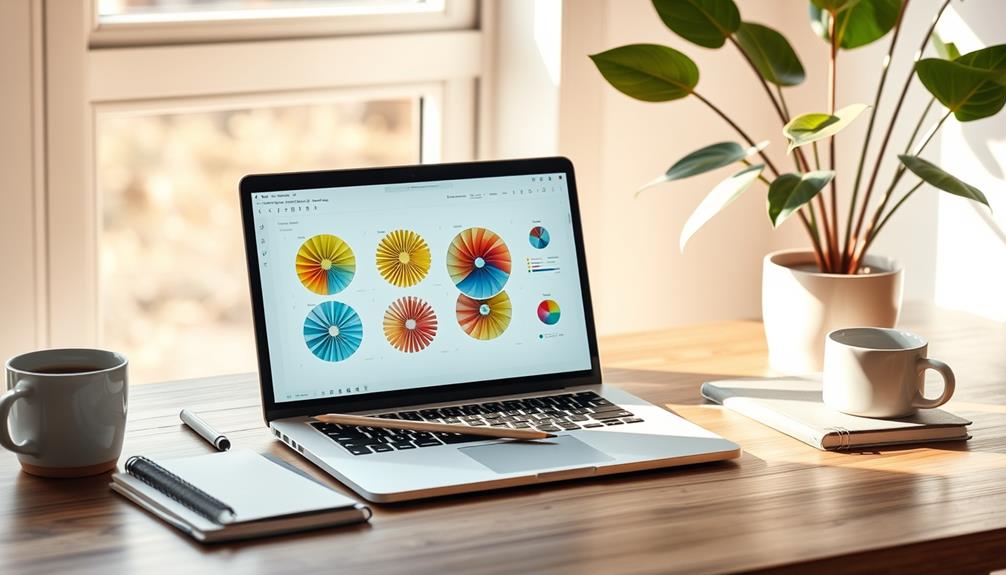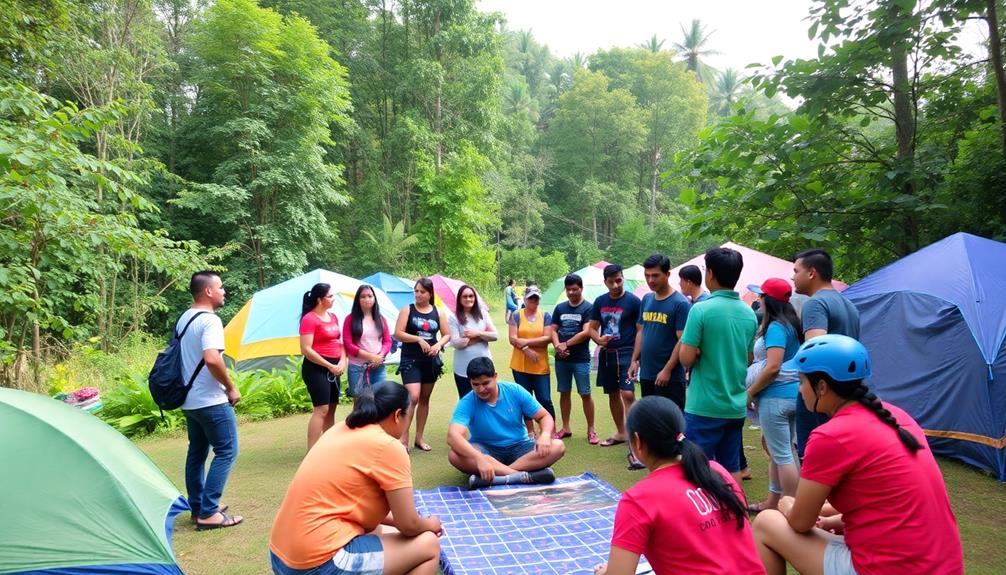Batik design is the decor trend you didn't know you needed to transform your home. With its vibrant colors and intricate patterns, it injects texture and warmth into any space. This timeless art form originated in Indonesia and adds a rich cultural flair to your decor. You can easily incorporate batik through throw pillows, wall art, or table linens. Whether you prefer earthy tones or bright hues, batik's versatility complements all styles, from rustic to modern. Discover how these unique textiles can bring your spaces to life and spark creativity in every corner of your home.
Key Takeaways
- Batik textiles bring vibrant colors and intricate patterns, adding a unique aesthetic to any home decor style.
- Incorporating batik pieces showcases cultural heritage, enriching your space with stories and traditions.
- Versatile batik items like throw pillows and wall art enhance comfort and visual appeal in living areas.
- The trend offers sustainable craftsmanship opportunities, promoting eco-friendly practices through DIY batik projects.
- Regular maintenance ensures batik textiles remain vibrant and durable, extending their charm in your home.
History of Batik Design
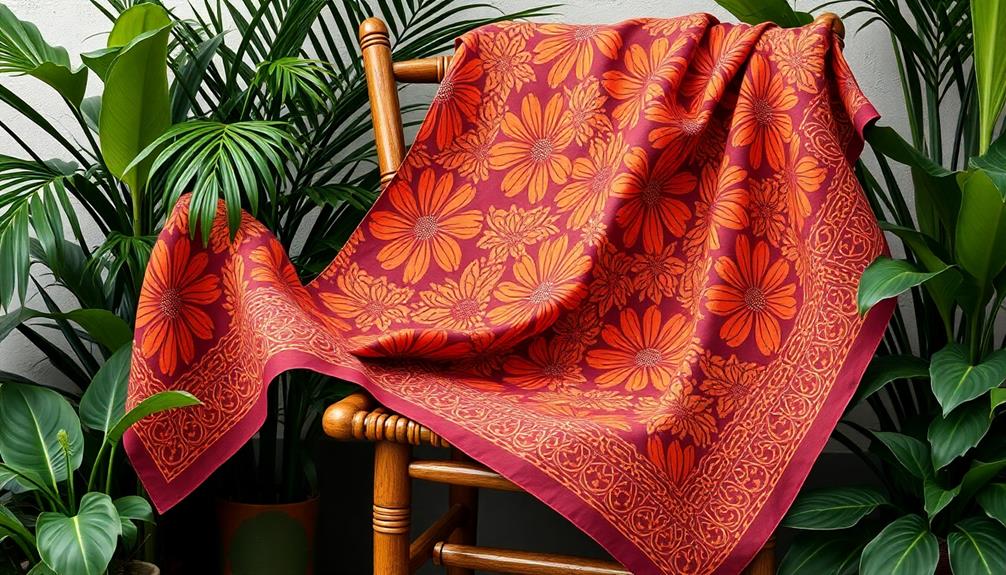
When you explore the fascinating world of batik design, you'll discover its rich history that dates back to the 6th century in Java, Indonesia. This traditional fabric dyeing technique involves applying wax to fabric in intricate designs before dyeing it. This unique process prevents the dye from penetrating the waxed areas, resulting in stunning patterns that tell stories of culture and tradition.
Additionally, batik shares similarities with other traditional Indonesian art forms, such as Indonesian decor masks, showcasing the diverse craftsmanship found throughout the archipelago.
Batik wasn't just a craft; it was historically used for ceremonial purposes and clothing for nobility. Each region in Indonesia has its own distinctive motifs and color schemes, reflecting local traditions and community identities.
The artistry and craftsmanship behind batik earned it recognition as a UNESCO Intangible Cultural Heritage of Humanity in 2009, going to show how significant this art form is worldwide.
Over the centuries, batik has evolved from a noble garment into a celebrated art form and a popular trend in home décor. Today, you can find batik patterns adorning everything from cushions to wall hangings, creating a vibrant connection to its rich cultural heritage.
Embracing batik in your home design isn't just a trend; it's a celebration of history and artistry.
Benefits of Batik in Decor
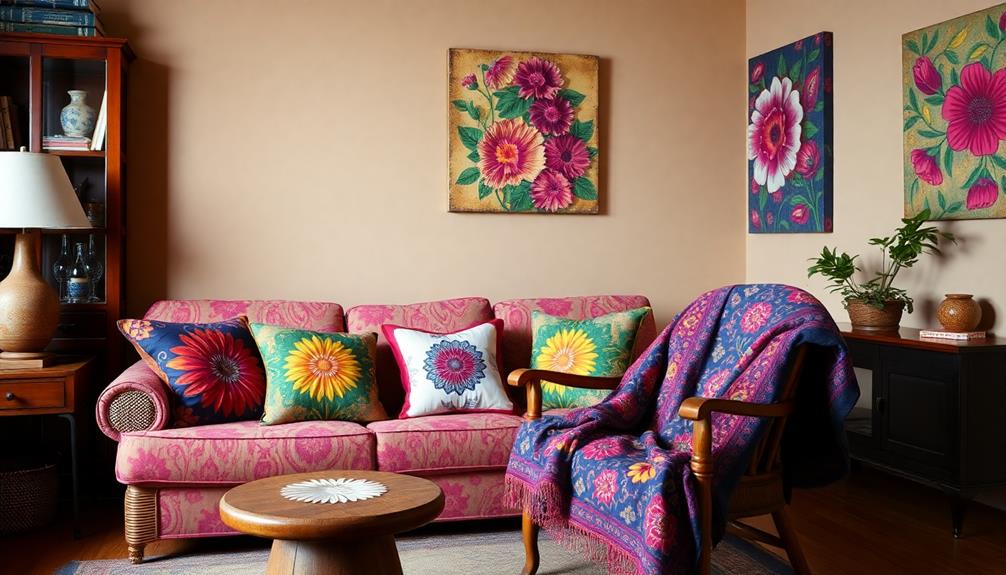
Incorporating batik into your home decor offers a multitude of benefits that enhance both aesthetics and atmosphere. First, batik fabric is known for its intricate patterns and vibrant colors, which add a unique cultural touch to your spaces. This personalization makes your home feel more inviting and reflects your individual style.
Additionally, batik textiles, such as decorative pillows, can enhance your living area by providing comfort while showcasing your cultural heritage, making it easy to explore Indonesian decorative pillows.
Using batik can also enhance your creativity and stimulate artistic expression. The designs often mirror nature and abstract themes, inspiring you to think outside the box.
By adding batik textiles like pillows or curtains, you create a cozy atmosphere that enriches the sensory appeal of your rooms.
Batik is also incredibly versatile, fitting seamlessly into various decor styles, from traditional to modern. This adaptability means you can easily integrate batik into your existing decor without clashing with your overall theme.
Popular Color Palettes
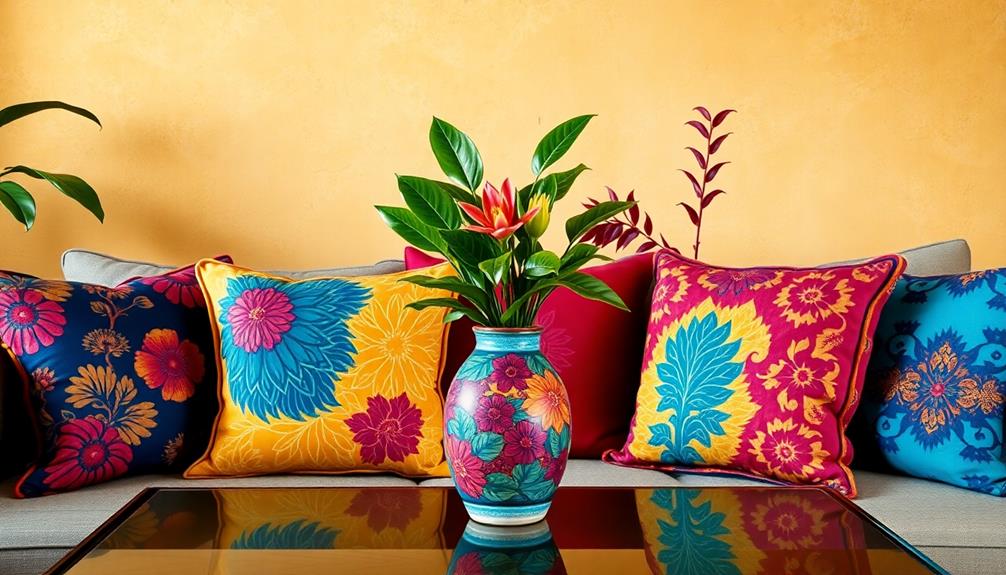
Color plays an essential role in batik design, influencing the mood and style of your home. If you're looking to create a warm and inviting atmosphere, consider rich, earthy tones like indigo, ochre, and rust. These colors can immediately transform any space into a cozy retreat, reflecting the rich cultural heritage of Southeast Asia decor.
On the other hand, if you want to inject some energy into your decor, bright palettes with turquoise, fuchsia, and lime green are going to show you how to liven things up, showcasing the vibrant colors commonly found in traditional textiles traditional and modern aesthetics.
For a more serene and cohesive look, you might opt for monochromatic schemes using varying shades of deep blues or greens. This approach works wonderfully with minimalist decor and creates a calming environment.
If you're aiming for a delicate touch, pastel colors like soft pinks and light yellows can introduce a soothing element, making them perfect for bedrooms or relaxation spaces.
Lastly, don't underestimate the power of metallic accents. Incorporating gold or copper with traditional batik colors can elevate your aesthetic, adding a contemporary twist to classic designs.
With these popular color palettes, you can easily find the perfect fit for your home's batik decor.
Incorporating Batik Textiles
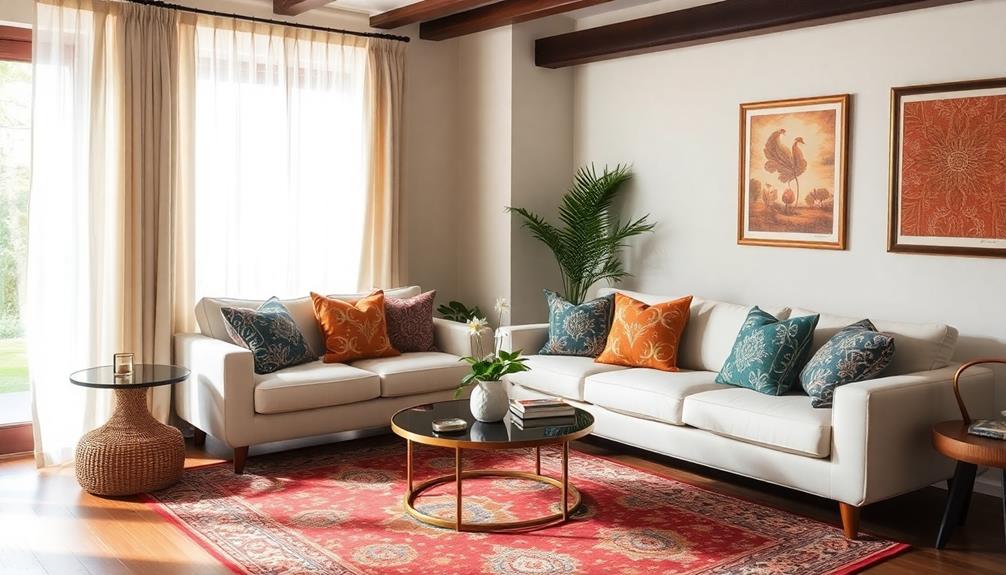
When you incorporate batik textiles into your home, you not only embrace their vibrant colors and intricate patterns but also connect with their rich history.
These textiles, much like traditional artistry in Indonesian decor masks, reflect the deep cultural roots and stories of the regions they originate from.
Understanding the unique designs can help you choose the right pieces that complement your style while ensuring proper care and maintenance keeps them looking fresh.
Let's explore how to make the most of these stunning fabrics in your decor.
History of Batik Textiles
Batik textiles have a rich history that spans over a millennium, tracing their origins back to at least the 6th century in ancient Java. This traditional art form is characterized by intricate patterns created using a wax-resist dyeing technique, making each piece unique.
As you explore the significance of batik, you're going to show your appreciation for its cultural depth. The artistry involved in batik creation reflects Indonesia's rich cultural heritage, much like the importance of Indonesian decor masks, which also celebrate the country's traditions.
Here are three key points about batik's history:
- Cultural Symbolism: Batik became a crucial aspect of identity and heritage in Indonesia, often used in ceremonies and significant life events.
- UNESCO Recognition: In 2009, UNESCO recognized batik as a Masterpiece of the Oral and Intangible Heritage of Humanity, underscoring its role in cultural expression.
- Evolution Over Time: While rooted in tradition, batik has evolved, influencing contemporary fashion and home décor, making it a trendy choice for modern interiors.
Understanding the history of batik enriches your experience when incorporating these textiles into your home, allowing you to celebrate a timeless craft that continues to inspire.
Color and Pattern Choices
Incorporating batik textiles into your home decor can transform your space with vibrant colors and intricate patterns. When you choose batik, you're going to show a flair for bold design and cultural heritage. Popular color choices include earthy tones like browns and greens, alongside vibrant indigo, crimson, and mustard shades that evoke warmth and liveliness.
To help you visualize the impact of these textiles, here's a quick reference table:
| Color Palette | Example Patterns |
|---|---|
| Earthy Tones | Leafy motifs |
| Vibrant Shades | Geometric designs |
| Large Patterns | Statement wall art |
| Intricate Designs | Textured throw pillows |
When selecting patterns, consider the scale. Larger designs can be focal points, while smaller ones add subtle texture. Combining batik with neutral furnishings creates a balanced aesthetic, letting the colorful patterns shine without overwhelming your decor. You can incorporate batik into various items, such as throw pillows, wall art, and table linens, providing versatility and a unique touch to your home. So go ahead, embrace the batik design trend and elevate your space!
Care and Maintenance Tips
Maintaining the beauty of your batik textiles is key to keeping your home decor vibrant and fresh. Incorporating batik textiles into your space can enhance the overall aesthetic, especially when combined with natural materials and earthy tones characteristic of Balinese design elements.
I'm going to show you some essential care and maintenance tips to help you preserve those stunning pieces.
- Hand Wash Gently: Always hand-wash your batik textiles in cold water with a mild detergent. This helps preserve their vibrant colors and intricate designs. Avoid bleach or harsh chemicals, as they can damage the fabric and lead to fading.
- Air Dry Properly: After washing, air dry your textiles away from direct sunlight. This prevents color deterioration and helps maintain the fabric's strength, keeping your batik looking new for longer.
- Iron with Care: When it's time to iron, set your iron to a low heat. Always iron on the reverse side to avoid scorching the delicate designs. This simple step can make a big difference in keeping your textiles looking crisp.
Batik Wall Art Ideas
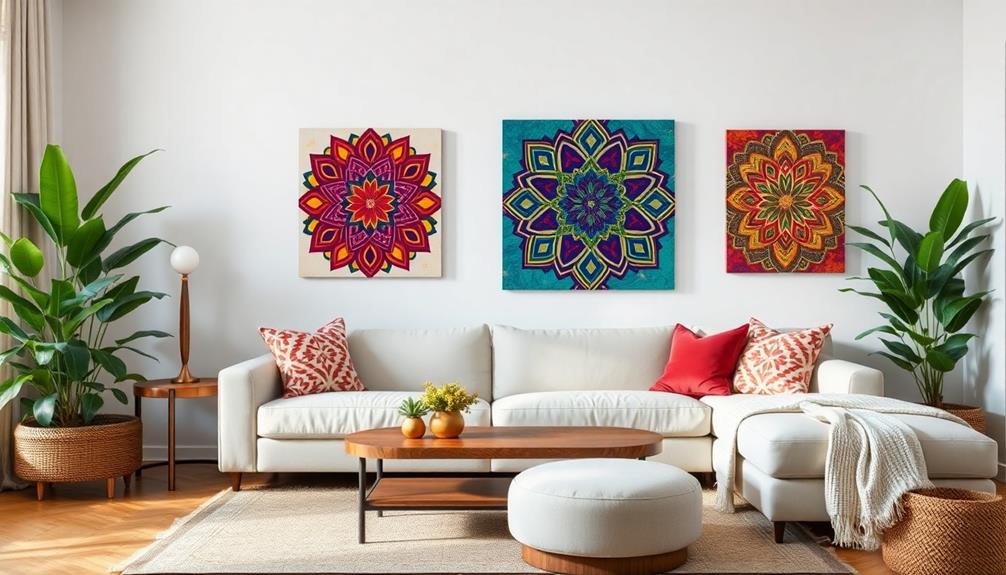
Transform your walls with the vibrant beauty of batik wall art, which offers a unique blend of tradition and creativity. If you're looking for batik wall art ideas, you're going to show your guests an enchanting focal point that enhances any room's decor.
Consider using large canvas prints that showcase intricate batik patterns; these can add a striking visual element to your living room or bedroom. Incorporating batik art into your space can also reflect the essence of traditional Indonesian style home decor, emphasizing harmony and natural aesthetics.
For a softer touch, think about fabric wall hangings. These can be draped or framed to create an organic aesthetic that complements various interior styles, from bohemian to modern.
Don't forget about the versatility of paper; you can craft beautiful collages or framed pieces that bring color and texture to your walls.
If you love experimenting, seek out batik art pieces that incorporate natural dyes, providing warmth and authenticity. You might even mix and match different sizes and styles for an eclectic gallery wall.
DIY Batik Projects
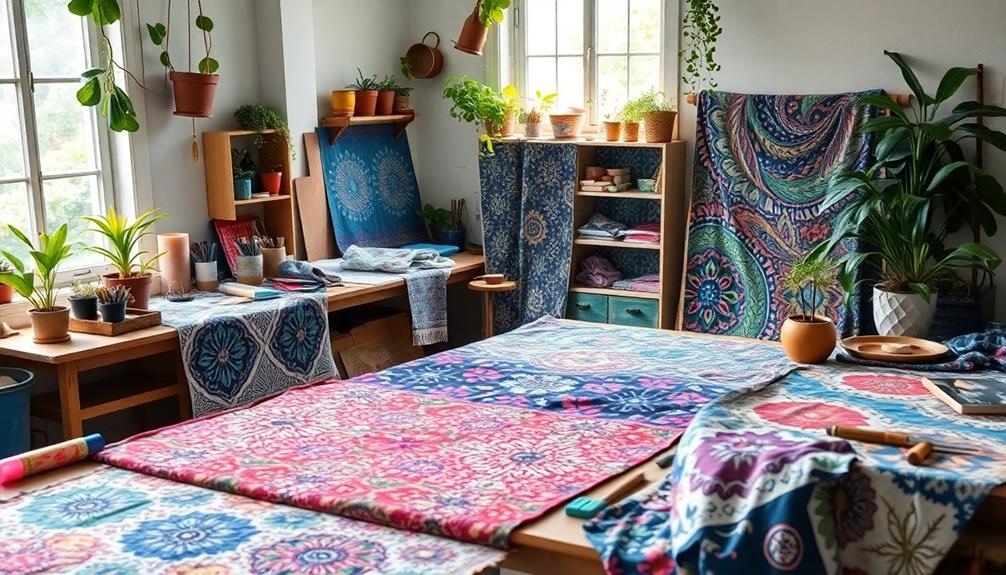
If you're ready to try your hand at DIY Batik projects, you'll need some essential materials like cotton fabric, wax, and dye.
Incorporating traditional motifs and patterns can enhance the cultural significance of your creations.
We'll walk you through step-by-step techniques to create stunning designs that can elevate your home decor.
Get set to release your creativity and bring a touch of tradition into your living space!
Essential Materials Needed
To commence your DIY Batik projects, gathering the right materials is essential. Incorporating elements of luxury tropical designs can inspire your Batik patterns and colors, adding an exotic flair to your home.
I'm going to show you what you need to create beautiful designs that will enhance your home. Here's a quick list of must-have materials:
- High-quality cotton fabric: This absorbs dyes well and provides a smooth surface for your designs.
- Wax resist: Choose between paraffin or beeswax to block dye from penetrating certain areas of the fabric, allowing for intricate patterns.
- Fabric dye: Use colorants specifically designed for cotton to achieve vibrant and long-lasting results in your Batik designs.
You'll also need a tjanting tool or a paintbrush for applying the wax resist, ensuring detailed line work.
Finally, don't forget a heat source, like a double boiler or electric skillet, to melt the wax for application and later removal after dyeing.
With these materials in hand, you're ready to plunge into the exciting world of Batik.
You'll find that each element plays a vital role in bringing your creative visions to life, making your DIY projects both rewarding and beautiful.
Step-by-Step Techniques
Batik is an art form that invites you to explore your creativity while adding a personal touch to your home decor. You can enhance your batik creations by integrating elements of sustainable craftsmanship found in Balinese furniture.
If you're ready to plunge into it, I'm going to show you step-by-step techniques for creating your own beautiful batik fabric.
Start by selecting a fabric like cotton or silk—these absorb dye well. Prepare your workspace with protective coverings to prevent any stains.
Next, use a wax resist technique. Melt the wax and apply it to areas of the fabric where you want to keep the original color, creating your desired patterns.
Once the wax cools and hardens, it's time to dye your fabric. Submerge it in a dye bath, ensuring the waxed areas remain untouched while the dye penetrates the rest.
After dyeing, remove the wax by boiling the fabric or using an iron to melt it away, revealing the stunning batik pattern underneath.
Finish your project by washing the fabric to set the dye. This enhances the vibrancy of the colors, making it perfect for home decor items like wall hangings or cushions.
Enjoy your unique batik creations!
Where to Find Batik Pieces
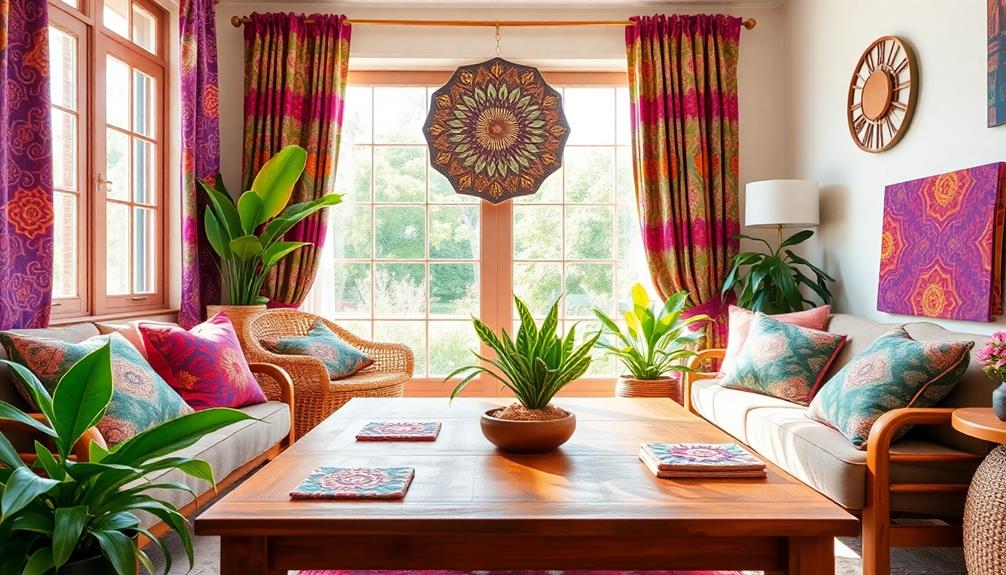
Finding beautiful batik pieces for your home is easier than ever with a variety of options available.
Whether you're looking to add a touch of tradition or modern flair, I'm going to show you where to look. Here are three great sources to explore:
- Local Artisan Markets: Visit nearby artisan markets where craftsmen sell handmade textiles showcasing traditional batik techniques. You'll find unique items that often tell a story.
- Online Marketplaces: Websites like Etsy and Amazon offer a wide range of batik home decor items. You can discover cushions, wall hangings, and tablecloths from global sellers, all available at your fingertips.
- Social Media Platforms: Check out Instagram and Pinterest to find independent artists and brands specializing in batik creations. These platforms often feature stunning visuals and direct links to purchase.
Additionally, don't overlook cultural festivals or exhibitions focused on textiles.
These events often highlight batik artisans, giving you a chance to purchase unique pieces directly.
With these options, you're sure to find the perfect batik items to enhance your home decor.
Frequently Asked Questions
Is Board and Batten Out of Style in 2025?
No, board and batten isn't out of style in 2025. Its versatility and ability to add texture keep it relevant, especially as homeowners mix it with other treatments for unique, personalized spaces. You'll love it!
What Is Design in Interior Design?
They say, "Home is where the heart is." In interior design, you arrange colors, textures, and spaces to create a specific mood and function, enhancing your living experience while reflecting your personal style and taste.
Conclusion
Incorporating batik design into your home is like adding a splash of vibrant color to a blank canvas. With its rich history and versatile appeal, batik can transform any space into a warm, inviting haven. Whether you choose bold textiles or stunning wall art, these pieces tell a story that resonates with your personal style. So, don't hesitate to plunge into the world of batik—your home deserves a touch of this unique artistry! The history of batik can be traced back to ancient civilizations, where it was used as a form of expression and cultural identity. Today, incorporating batik into your home allows you to connect with this rich tradition and infuse your space with a sense of heritage. Whether you opt for traditional batik motifs or modern interpretations, the history of batik adds depth and meaning to your home decor.
